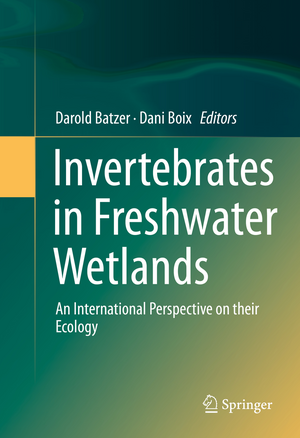Invertebrates in Freshwater Wetlands: An International Perspective on their Ecology
Editat de Darold Batzer, Dani Boixen Limba Engleză Hardback – 15 feb 2016
| Toate formatele și edițiile | Preț | Express |
|---|---|---|
| Paperback (1) | 1010.48 lei 6-8 săpt. | |
| Springer – 29 mar 2018 | 1010.48 lei 6-8 săpt. | |
| Hardback (1) | 1240.16 lei 6-8 săpt. | |
| Springer International Publishing – 15 feb 2016 | 1240.16 lei 6-8 săpt. |
Preț: 1240.16 lei
Preț vechi: 1512.39 lei
-18% Nou
Puncte Express: 1860
Preț estimativ în valută:
237.34€ • 246.87$ • 195.93£
237.34€ • 246.87$ • 195.93£
Carte tipărită la comandă
Livrare economică 14-28 aprilie
Preluare comenzi: 021 569.72.76
Specificații
ISBN-13: 9783319249766
ISBN-10: 3319249762
Pagini: 686
Ilustrații: X, 645 p. 91 illus., 61 illus. in color.
Dimensiuni: 155 x 235 x 35 mm
Greutate: 1.09 kg
Ediția:1st ed. 2016
Editura: Springer International Publishing
Colecția Springer
Locul publicării:Cham, Switzerland
ISBN-10: 3319249762
Pagini: 686
Ilustrații: X, 645 p. 91 illus., 61 illus. in color.
Dimensiuni: 155 x 235 x 35 mm
Greutate: 1.09 kg
Ediția:1st ed. 2016
Editura: Springer International Publishing
Colecția Springer
Locul publicării:Cham, Switzerland
Public țintă
GraduateCuprins
1. Introduction to wetland invertebrates ,Darold Batzer (USA), Dani Boix (ESP).- 2. Temperate seasonal ponds Michael Jeffries (UK).- 3. Temporary ponds in Mediterranean climates Dani Boix, Leon Blaustein (ISR), Jamie Kneitel (USA), Allie Mokany (AUS), C. Duchet (ISR), J. Sala (ESP), S. Gascón (ESP), X. D. Quintana (ESP).- 4. Permanent and semi-permanent marshes, Kyle Zimmer (USA), Mark Hanson (USA).- 5. Lake-shore marshes, Matt Cooper (USA), Don Uzarski (USA).- 6. Temperate floodplains, Darold Batzer, Belinda Gallardo (ESP), Andrew Boulton (AUS), Matt Whiles (USA).- 7. Tropical floodplains , Karl Wantzen (FRA), Marinez Isaac (BRA), Mercedes Marchese (ARG), Ines Ezcurra (ARG).- 8. Alpine and montane wetland ponds, Beat Oertli (SWI), Scott Wissinger (USA).- 9. Peatlands Darold Batzer, Terry Wheeler (CAN), Wu Haitao (CHINA), Sue Eggert (USA).- 10. Groundwater springs and seeps, Dudley Williams (CAN).- 11. Rock pools.- Luc Brendonck (BEL), Bram Vanschoenwinkel (BEL), Merlijn Jocqué (BEL).- 12. Beaver wetlands , Bryana Libby (USA), Scott Wissinger.- 13. Everglades , Joel Trexler (USA).- 14. Turloughs, Julian Reynolds (IRE).- 15. Constructed and restored wetlands ,Albert Ruhí (ESP), Winfield Fairhild (USA), Douglas Spieles (USA), Gustavo Becerra-Jurado (IRE), David Moreno-Mateos (FRA).- 16. Managed waterfowl marshes, Josh Stafford (USA), Steven Chipps (USA),.- 17. Synthesis, Dani Boix, Darold Batzer.
Recenzii
“Invertebrates in Freshwater Wetlands, the editors, along with their contributing authors, address this knowledge gap by summarizing published research on wetlands from temperate and tropical regions and from lowland to alpine systems. … A book dedicated to invertebrate ecology and diversity in wetlands is overdue. Aquatic ecologists, natural resource managers, and even educated general readers will find this an interesting and informative read.” (Barbara Hayford, The Quarterly Review of Biology, Vol. 93 (4), December, 2019)
Notă biografică
Darold Batzer serves as Professor in the University of Georgia's department of Entomology. He has edited five books on wetlands and served as Editor-in-Chief of Wetlands, the major journal cover the topic, from 2006 to 2012. Dani Boix serves as Aggregate Professor at the University of Girona, Spain's Institute of Aquatic Ecology and Department of Environmental Sciences. He has conducted extensive research and published widely on wetland invertebrates.
Textul de pe ultima copertă
Wetlands are among the world’s most valuable and most threatened habitats, and in these crucially important ecosystems, the invertebrate fauna holds a focal position. Most of the biological diversity in wetlands is found within resident invertebrate assemblages, and those invertebrates are the primary trophic link between lower plants and higher vertebrates (e.g. amphibians, fish, and birds). As such, most scientists, managers, consultants, and students who work in the world’s wetlands should become better informed about the invertebrate components in their habitats of interest. Our book serves to fill this need by assembling the world’s most prominent ecologists working on freshwater wetland invertebrates, and having them provide authoritative perspectives on each the world’s most important freshwater wetland types. The initial chapter of the book provides a primer on freshwater wetland invertebrates, including how they are uniquely adapted for life in wetland environments and how they contribute to important ecological functions in wetland ecosystems. The next 15 chapters deal with invertebrates in the major wetlands across the globe (rock pools, alpine ponds, temperate temporary ponds, Mediterranean temporary ponds, turloughs, peatlands, permanent marshes, Great Lakes marshes, Everglades, springs, beaver ponds, temperate floodplains, neotropical floodplains, created wetlands, waterfowl marshes), each chapter written by groups of prominent scientists intimately knowledgeable about the individual wetland types. Each chapter reviews the relevant literature, provides a synthesis of the most important ecological controls on the resident invertebrate fauna, and highlights important conservation concerns. The final chapter synthesizes the 15 habitat-based chapters, providing a macroscopic perspective on natural variation of invertebrate assemblage structure across the world’s wetlands and a paradigm for understanding how global variation and environmental factors shape wetland invertebrate communities.
Caracteristici
Describes the invertebrates of diverse wetlands around the world
Provides a primer on freshwater wetland invertebrates, including how they are uniquely adapted for life in wetland environments and how they contribute to important ecological functions in wetland ecosystems
Features chapters from authors across Europe, North and South America, Australia, and Asia
Includes supplementary material: sn.pub/extras
Provides a primer on freshwater wetland invertebrates, including how they are uniquely adapted for life in wetland environments and how they contribute to important ecological functions in wetland ecosystems
Features chapters from authors across Europe, North and South America, Australia, and Asia
Includes supplementary material: sn.pub/extras














